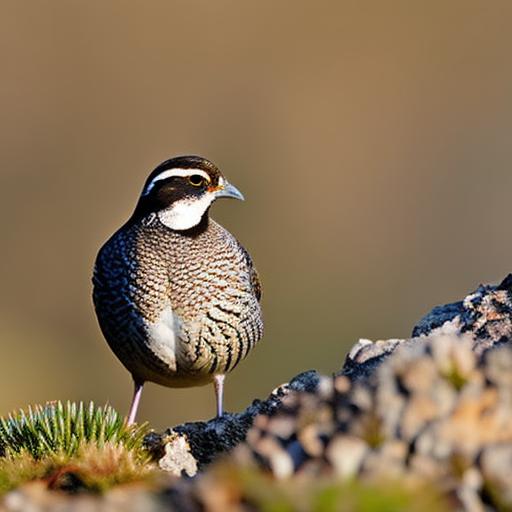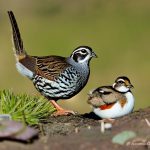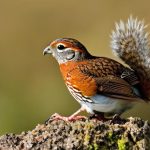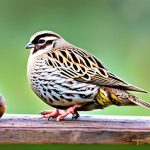The California quail, also known as the Valley quail, is a small ground-dwelling bird native to the western United States. These charming birds are known for their distinctive appearance, with a plump body, forward-drooping crest, and striking black and white markings on their face. They are popular among aviculturists and bird enthusiasts for their beautiful plumage and delightful calls. California quails are social birds that thrive in small flocks, making them a joy to observe in a captive setting.
In the wild, California quails inhabit a variety of habitats, including chaparral, sagebrush, and woodland areas. They are ground foragers, feeding on seeds, insects, and vegetation. In captivity, they require a spacious and secure enclosure that mimics their natural environment to ensure their health and well-being. Additionally, providing a balanced diet, appropriate nesting sites, and opportunities for socialization and enrichment are essential for the overall welfare of California quails in captivity. This article will provide an in-depth look at the housing, diet, breeding, health care, and legal considerations for keeping California quails as pets or in a captive setting.
Key Takeaways
- California Quail are small, ground-dwelling birds native to the western United States.
- They require spacious enclosures with plenty of hiding spots and vegetation for nesting and protection.
- A balanced diet for California Quail includes seeds, insects, and fresh greens.
- Breeding California Quail requires a well-planned nesting area and careful monitoring of the mating process.
- Regular health check-ups and access to a qualified avian veterinarian are essential for the well-being of California Quail.
Housing and Enclosure Requirements
When it comes to housing California quails, providing a spacious and secure enclosure is crucial for their well-being. The enclosure should be large enough to accommodate the birds’ natural behaviors, such as foraging, dust bathing, and socializing. A minimum of 20 square feet per pair of quails is recommended to ensure they have ample space to move around and exercise. The enclosure should also be predator-proof, with sturdy walls and a secure roof to protect the birds from potential threats.
In addition to space and security, the enclosure should also include natural elements to mimic the quails’ natural habitat. This can include native vegetation, such as shrubs and grasses, as well as natural substrate for dust bathing. Providing hiding spots and sheltered areas within the enclosure will also help the quails feel secure and reduce stress. It’s important to regularly clean the enclosure and provide fresh bedding to maintain a clean and healthy environment for the birds. Overall, creating a naturalistic and secure enclosure is essential for the physical and psychological well-being of California quails in captivity.
Diet and Nutrition
California quails have specific dietary needs that must be met to ensure their health and well-being in captivity. In the wild, they primarily feed on a variety of seeds, insects, and vegetation. In a captive setting, it’s important to provide a balanced diet that mimics their natural food sources. A high-quality game bird feed can serve as the foundation of their diet, supplemented with fresh greens, fruits, and vegetables. Additionally, offering grit or coarse sand will help the quails with digestion by grinding up their food in their gizzards.
It’s important to monitor the quails’ food intake and adjust their diet as needed to maintain a healthy weight and condition. Providing access to clean, fresh water at all times is also essential for their overall health. Additionally, offering occasional treats such as mealworms or small amounts of fruit can provide enrichment and variety in their diet. It’s important to avoid feeding them toxic plants or foods high in salt or sugar. By providing a balanced and varied diet, you can ensure that your California quails receive the nutrition they need to thrive in captivity.
Breeding and Reproduction
Breeding California quails can be a rewarding experience for aviculturists and bird enthusiasts. Before attempting to breed quails, it’s important to ensure that you have a suitable breeding pair and a well-prepared breeding environment. Quails reach sexual maturity at around 3-4 months of age, at which point they may begin to display courtship behaviors. Providing a suitable nesting site within the enclosure is essential for successful breeding. This can include natural materials such as grass, straw, or dried leaves in a secluded area of the enclosure.
Once the quails have successfully mated and laid eggs, it’s important to provide them with privacy and minimal disturbance to ensure the success of the breeding process. The female will typically incubate the eggs for around 21 days before they hatch. Once the chicks have hatched, it’s important to provide them with a warm and safe environment, as well as a diet rich in protein to support their growth and development. Breeding California quails requires careful observation and attention to detail to ensure the health and well-being of both the parents and the chicks. With proper care and attention, breeding California quails can be a fulfilling experience for bird enthusiasts.
Health and Veterinary Care
Maintaining the health of California quails in captivity requires regular observation, proper nutrition, and access to veterinary care when needed. It’s important to monitor the quails for any signs of illness or injury, such as changes in behavior, appetite, or droppings. Providing a clean environment with access to fresh water and a balanced diet will help prevent many common health issues. Additionally, regular cleaning of the enclosure and providing opportunities for dust bathing will help prevent parasites and skin issues.
In the event that a quail becomes ill or injured, it’s important to seek veterinary care from a professional experienced in avian medicine. Finding a veterinarian who is knowledgeable about quail care is essential for providing appropriate treatment and care for these birds. It’s also important to be aware of common health issues that can affect California quails, such as respiratory infections, egg binding in females, or injuries from predators or other birds. By staying vigilant and providing proper care and attention, you can help ensure the health and well-being of your California quails in captivity.
Behavioral Enrichment and Socialization
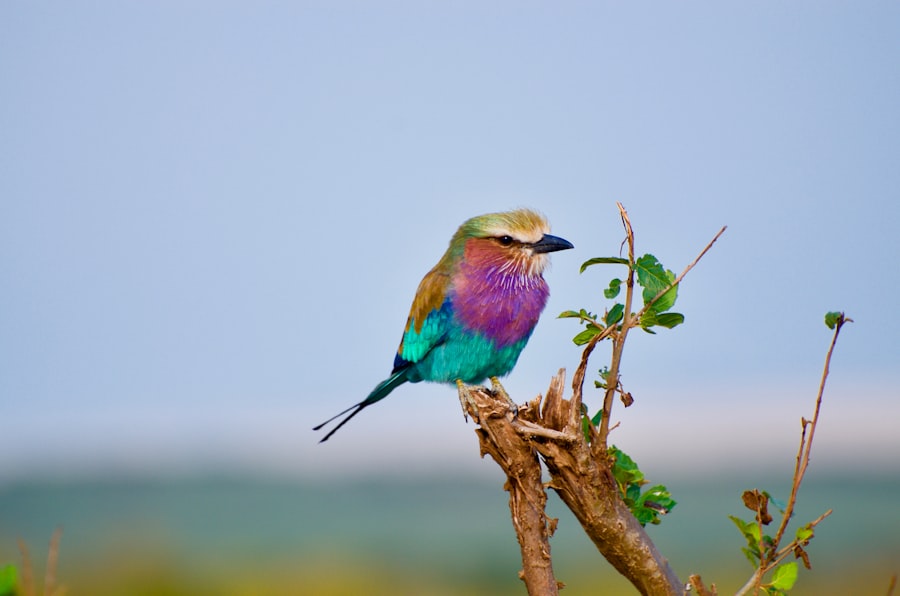
California quails are social birds that thrive in small flocks, making socialization an important aspect of their care in captivity. Providing opportunities for social interaction within the flock can help reduce stress and promote natural behaviors. This can include providing perches or roosting areas within the enclosure where the quails can gather together. Additionally, offering natural materials such as branches or logs can provide opportunities for exploration and enrichment.
In addition to socialization, providing opportunities for behavioral enrichment is essential for the overall well-being of California quails in captivity. This can include offering opportunities for foraging by scattering food throughout the enclosure or providing puzzle feeders that require problem-solving skills. Dust bathing areas should also be provided to allow the quails to engage in this natural behavior. Offering toys or objects for pecking and exploration can also provide mental stimulation for the birds. By providing opportunities for socialization and enrichment, you can help ensure that your California quails lead fulfilling lives in captivity.
Legal Considerations and Permits
Before acquiring California quails for captivity, it’s important to be aware of any legal considerations or permits that may be required in your area. In some regions, keeping California quails may be subject to regulations or permit requirements due to their status as native wildlife. It’s important to research local laws and regulations regarding the keeping of quails as pets or in a captive setting.
Additionally, if you plan to breed or sell California quails, you may need to obtain specific permits or licenses from local authorities or wildlife agencies. Ensuring that you are in compliance with all relevant laws and regulations is essential for the responsible ownership of California quails. By being aware of legal considerations and obtaining any necessary permits, you can ensure that you are keeping your quails in accordance with local laws while also promoting conservation efforts for these charming birds.
In conclusion, keeping California quails in captivity requires careful consideration of their housing, diet, breeding, health care, socialization, and legal considerations. By providing a spacious and secure enclosure that mimics their natural habitat, offering a balanced diet rich in nutrients, providing opportunities for breeding and reproduction when appropriate, seeking veterinary care when needed, promoting socialization and behavioral enrichment within the flock, and being aware of legal considerations and permits required in your area, you can ensure that your California quails thrive in captivity while also contributing to conservation efforts for these delightful birds.
If you’re interested in keeping California quail, you may also want to consider setting up a suitable coop for them. Producers Pride Sentinel Chicken Coop is a great option for providing a safe and comfortable environment for your quail. This coop offers ample space and protection, ensuring the well-being of your birds. Check out this article on Producers Pride Sentinel Chicken Coop to learn more about creating the perfect habitat for your quail.
FAQs
What is the California quail?
The California quail (Callipepla californica) is a small ground-dwelling bird native to the western United States. It is known for its distinctive teardrop-shaped plume on its head and its vibrant plumage.
What do California quails eat?
California quails primarily feed on a diet of seeds, fruits, and insects. They forage on the ground, using their strong beaks to peck at food items.
Where do California quails live?
California quails are found in a variety of habitats, including chaparral, sagebrush, woodland edges, and suburban areas with suitable cover and food sources. They are commonly found in California, but also inhabit parts of Oregon, Washington, and Baja California.
How do California quails reproduce?
California quails form monogamous pairs during the breeding season. The female builds a shallow depression on the ground and lays a clutch of 12-16 eggs. Both parents share the responsibility of incubating the eggs and caring for the chicks.
Are California quails protected species?
California quails are not considered a threatened or endangered species. However, they are protected under the Migratory Bird Treaty Act, which regulates the hunting and protection of migratory birds in the United States.
Meet Walter, the feathered-friend fanatic of Florida! Nestled in the sunshine state, Walter struts through life with his feathered companions, clucking his way to happiness. With a coop that’s fancier than a five-star hotel, he’s the Don Juan of the chicken world. When he’s not teaching his hens to do the cha-cha, you’ll find him in a heated debate with his prized rooster, Sir Clucks-a-Lot. Walter’s poultry passion is no yolk; he’s the sunny-side-up guy you never knew you needed in your flock of friends!

